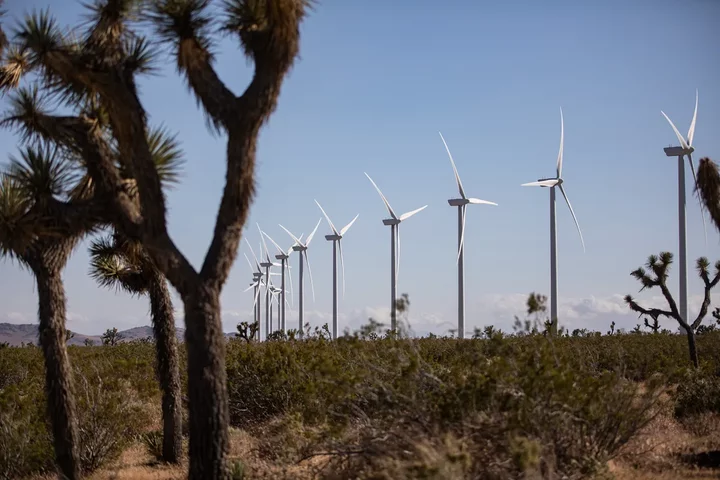Wind turbines lined up off Highway 58 in the Tehachapi Pass Wind Farm near Mojave on May 10, 2023. Photo by Larry Valenzuela, CalMatters/CatchLight Local
###
This story was originally published by CalMatters. Sign up for their newsletters.
###
California’s drive to run its electric grid entirely on wind, solar and other clean sources of energy just got harder after President Donald Trump signed a sweeping new budget law.
The changes in federal tax incentives could affect the feasibility of new solar and wind projects as the state is counting on them to provide more electricity for Californians. A state law requires 100% of electricity to be powered by renewable, carbon-free sources by 2045, at the same time it’s moving to electrify cars and trucks.
Incentives championed by former President Joe Biden were rolled back, shortening the timeline for the industry to obtain tax credits. Developers of wind and solar projects now face a new, shorter deadline for obtaining tax credits — most now expire at the end of 2027 instead of no sooner than 2032.
In addition, the new federal rules bar companies from accessing tax credits if they rely on major components from China or other “foreign entities of concern.” This restriction could hit California’s solar and wind industry especially hard, experts said.
The changes to tax credits are estimated to save the federal government approximately $499 billion from 2025–2034.
“For too long, the Federal Government has forced American taxpayers to subsidize expensive and unreliable energy sources like wind and solar,” Trump wrote in an executive order last week. “The proliferation of these projects displaces affordable, reliable, dispatchable domestic energy sources, compromises our electric grid, and denigrates the beauty of our Nation’s natural landscape.”
Projects can still be built without tax credits. But it puts more of a financial burden on their investors. In California, 11 solar projects and one onshore wind project now face potential delays or cancellation, according to an analysis of federal data by Atlas Public Policy provided to CalMatters. The projects are spread across the Central Valley, Inland Empire and Northern California.
Sean Gallagher, senior vice president of policy for the Solar Energy Industries Association, said in a statement that the industry was still “assessing what the federal tax bill means for them.” He warned the changes could jeopardize up to 35,700 solar jobs and 25 solar manufacturing facilities in California — including existing positions and factories as well as future projects that may now never materialize.
“The reality is, with or without clean energy tax credits, California’s energy demand is growing at a historic rate, and solar and storage are the fastest and most affordable way to meet that demand,” Gallagher said.
California in recent years has been fast-tracking massive floating offshore wind farms 20 miles off the coasts of Humboldt County and Morro Bay. The federal changes add some uncertainty that could chill investment. But experts say it’s not a death knell for the industry because the projects weren’t set to seek federal permits or generate electricity for at least several years.
“Offshore wind is what we would call a long-lead project. It does take years and years to develop,” said Assemblymember Dawn Addis, former chair of the Assembly’s Offshore Wind Select Committee. “Solar is a little bit shorter of a time frame…but it’s also his incredibly erratic behavior when it comes to market stability overall that is also going to affect these projects in a negative way.”
Experts say in the long-run, the federal changes could drive up energy costs.
“Tax credit savings are typically passed onto ratepayers through lower contracting costs. In the long term, the repeal of the tax credits will result in higher future electricity rates for customers,” the California Energy Commission told CalMatters.
Rising utility bills are already a major political headache for state leaders and a challenge for clean energy advocates who want the state to lead the way in making electricity cleaner, cheaper, and more reliable.
“The whole point of California’s climate policy is not just to reduce California’s carbon footprint — because we are less than 1% of global emissions — but to set an example and show that this can be done,” Berkeley economist Severin Borenstein told CalMatters. “There are going to be fewer other states following our example because it’s going to be more expensive.”

CLICK TO MANAGE